Introduction
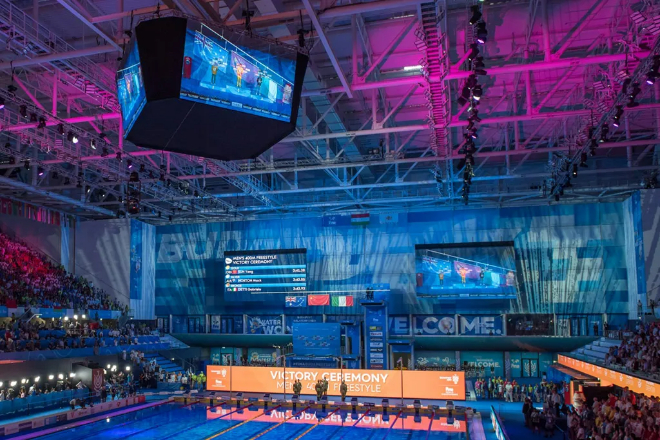
In modern gymnasiums, Écrans d'affichage LED have become an indispensable part of an important information display and visual display tool.
When installing LED display screens in gymnasiums, hanging type, and wall-mounted type are two common installation methods. These two methods have their own advantages.
Choosing which installation method is better needs to be comprehensively considered according to the actual situation of the gymnasium, activity requirements, budget, and other factors.
1. Advantages and disadvantages of hanging installation method of LED display screen in gymnasium
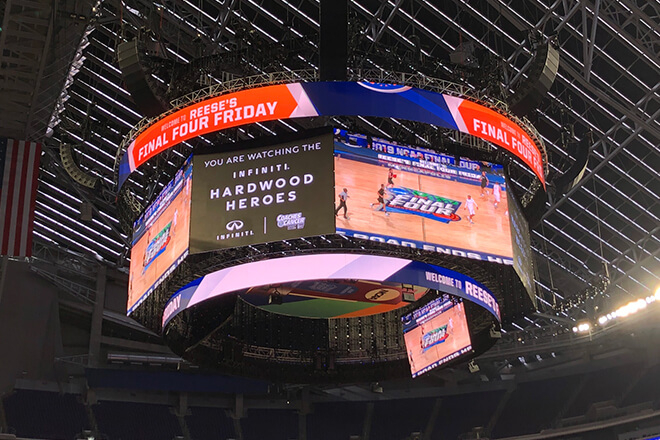
The hanging installation method of the LED display screens in the gymnasium does have its unique characteristics, advantages, and disadvantages that need to be considered. The following is a detailed explanation of these aspects:
1). Features of hanging installation
1.1). Suspension by hanger or steel cable:
The hanging installation fixes the LED display screen in the air through a hanger or steel cable. This installation method allows the display screen to float in the gymnasium without occupying ground space.
1.2). Suitable for high or open areas:
Since the space inside the gymnasium is often high and open, the hanging installation can make full use of these spaces and place the display screen in the best viewing position.
2). Avantages
2.1). Wide field of view and good viewing experience for the audience:
The suspended installation allows the display screen to be located in the center or high position of the gymnasium, ensuring that all spectators can get a good line of sight no matter where they sit.
2.2). Save ground space:
Through suspended installation, the display screen does not occupy the floor space of the gymnasium, which allows the gymnasium to arrange other facilities more flexibly, such as basketball courts, football fields, auditoriums, etc.
2.2). Flexible installation location:
Suspended installation allows the height and angle of the display screen to be flexibly adjusted according to the actual needs of the gymnasium and the distribution of the audience to achieve the best viewing effect.
3). Disadvantages
3.1). High installation and maintenance costs:
Suspended installation requires professional lifting equipment and technology, including hangers, steel cables, cranes, etc., and the purchase and rental costs of these equipment are relatively high. At the same time, the safety risks and complexity of the installation process also increase the installation cost.
In terms of maintenance, since the display screen is suspended in the air, maintenance personnel need special equipment and skills to carry out inspection and maintenance, which also increases the maintenance cost.
3.2). There are certain safety hazards:
Suspension installation depends on the stability of the hanger and steel cable. If these parts are loose, broken, or corroded, the display may fall and cause damage to the audience and gymnasium facilities.
In addition, environmental factors in the gymnasium (such as wind, humidity, temperature, etc.) may also affect the stability of the suspension system, and regular safety inspections and maintenance are required.
2. Advantages and disadvantages of wall-mounted installation of LED display screens in gymnasiums
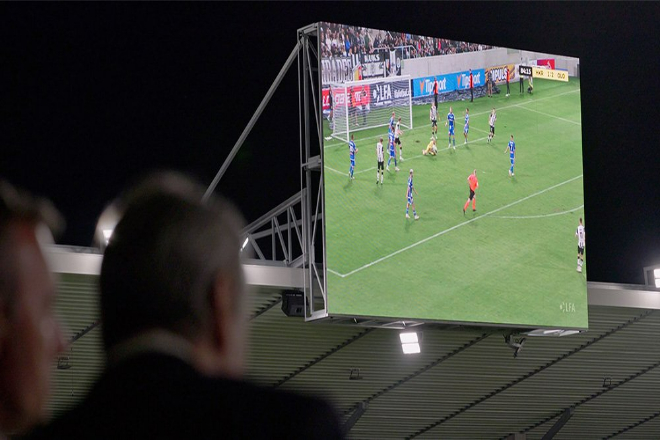
The advantages and disadvantages of wall-mounted installation of LED display screens in gymnasiums can be summarized as follows:
1). Wall-mounted installation features
Méthode fixe : Fix the display screen directly on the wall or column of the gymnasium and use the load-bearing capacity of the wall or column to support the display screen.
Scénarios applicables : Suitable for areas with flat walls and stable structures in gymnasiums to ensure that the display screen can be stably suspended and withstand vibration and impact during use.
2). Avantages
2.1). Simple and convenient installation:
Wall-mounted installation usually does not require complex wiring and fixtures, and the installation process is relatively simple and quick.
It can be easily installed with a standard wall mount, reducing installation time and cost.
2.2). Relatively low cost:
Compared with other installation methods (such as hanging, column installation, etc.), wall-mounted installation usually does not require additional support structures and hoisting equipment, so the cost is relatively low.
2.3). Stable structure, safe and reliable:
Wall-mounted installation fixes the display screen directly on the wall or column with a stable structure that is not easy to shake or fall off.
The display screen fits tightly to the wall and can effectively resist the influence of external factors such as wind, ensuring safety and stability during use.
2.4). Easy maintenance:
The wall-mounted installation makes the display screen easy to disassemble and replace, which is convenient for later maintenance and maintenance.
The modular design only requires the replacement of damaged modules during maintenance, without replacing the entire display screen, reducing maintenance costs.
3). Disadvantages
3.1). It may occupy a certain amount of wall space:
Wall-mounted installation fixes the display screen directly on the wall, which may occupy a certain amount of wall space and affect the layout of other facilities in the gymnasium (such as billboards, decorations, etc.).
It is necessary to carefully plan the use of wall space before installation to ensure that the installation of the display screen will not affect other facilities.
3.2). Limited angle de vue:
The viewing angle of the wall-mounted display is relatively fixed, and the audience may need to adjust the viewing angle according to the position to obtain the best viewing effect.
Especially when the audience seats are far away, or the angle is not good, other installation methods (such as hanging, column installation, etc.) may need to be considered to provide a wider viewing field.
3.3). Limited installation environment:
The wall-mounted installation has high requirements for the wall surface. It is necessary to ensure that the wall surface is flat, the structure is stable, and it can withstand the weight of the display screen and the vibration and impact during use.
If the wall conditions do not meet the requirements, additional reinforcement treatment or other installation methods may be required.
3. Analysis of actual application scenarios
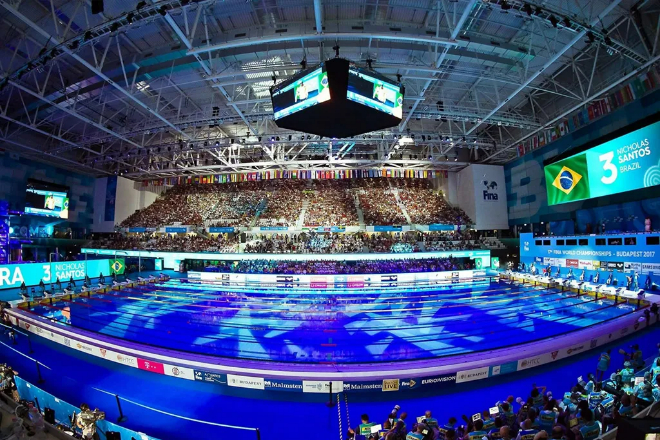
1). Large-scale sports events
- Suspended installation:
Large-scale sports events must use suspended installation! The venue space is large, and the suspended screen can be fully utilized to provide the audience with a wide field of view. Moreover, the screen can be raised, lowered, and rotated to meet the various needs of the game. It looks very high-tech!
- Wall-mounted installation:
Wall-mounted installation may not be suitable. The screen size and viewing angle are limited, and it cannot meet the viewing needs of the entire audience. After all, large-scale sports events must be enjoyable for everyone!
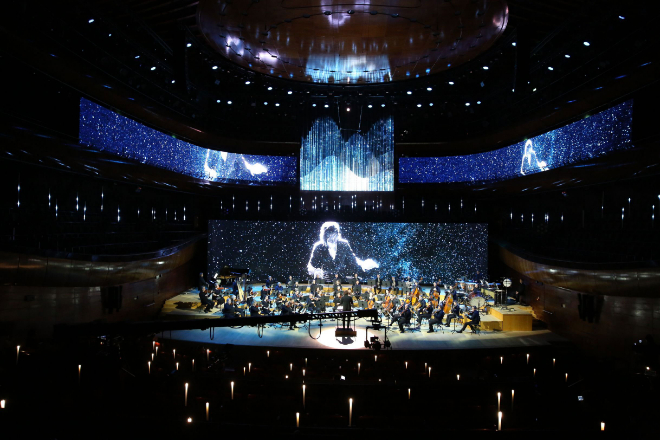
2). Theatrical performances
- Suspended installation:
It is also good to use suspended screens for theatrical performances! The screen can be changed in various ways according to the needs of the performance, giving the audience a richer visual experience.
Moreover, the suspended screen can also enhance the modern sense of the venue and make the performance more colorful!
- Wall-mounted installation:
Wall-mounted screens may also be used in theatrical performances, but it depends on the specific scene.
For example, background walls, the side of the organiser, etc. However, you still have to pay attention to the screen size and viewing angle.
3). Exhibition display
- Suspended installation:
It is also good to use suspended screens for exhibitions! The venue has a large space, and the suspended screen can display more exhibit information.
Moreover, the screen can be customized and adjusted according to the needs of the exhibition, providing a more personalized display effect. Let the audience enjoy the exhibition more!
- Wall-mounted installation:
Wall-mounted screens can also be used in exhibitions, but it may depend on the specific area or wall. It is good for displaying specific exhibit information or advertising content. However, you still have to pay attention to the screen size and viewing angle so as not to make the audience unable to see clearly.
In general, both hanging and wall-mounted installation methods have their own advantages and disadvantages and applicable scenarios. When choosing, you still have to consider the actual situation, audience needs, budget, and safety factors. After all, the audience must enjoy the show and use it comfortably!
4. Selection suggestions and precautions
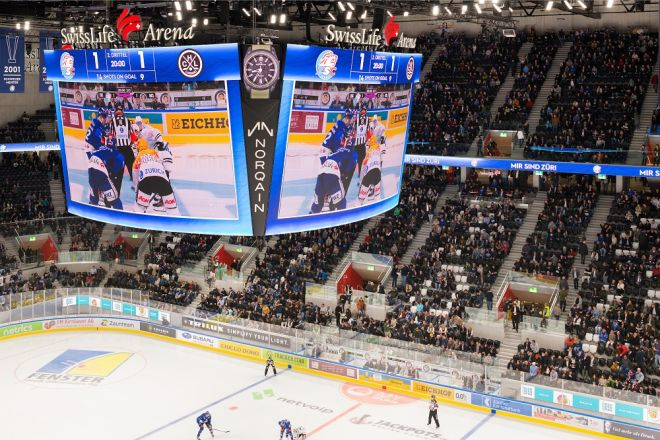
1). Selection suggestions
When choosing the installation method for the gymnasium LED display, we cannot blindly follow the trend or only focus on the price, but we need to consider multiple factors comprehensively to ensure that the final choice not only meets the actual needs but also has good cost performance.
1.1). Comprehensively consider the actual situation of the gymnasium, activity needs, and budget
- The actual situation of the gymnasium:
We need to carefully examine the architectural structure, space size, wall material, etc., of the gymnasium.
These factors will directly affect the installation method and effect of the LED display. For example, if the top structure of the gymnasium is strong and has a strong load-bearing capacity, then hanging installation may be a good choice.
If the wall is flat and has a suitable load-bearing capacity, then wall-mounted installation may also be suitable.
- Activity needs:
The type of activities held in the gymnasium is also an important factor to consider when choosing an installation method.
If you often hold large-scale sports events or cultural performances, you need to choose an installation method that can meet the viewing needs of a wide range of audiences, such as hanging; if it is mainly used for daily training or small events, then wall-mounted may be sufficient.
- Budget:
Budget is a realistic factor that we have to consider when choosing an installation method. Suspended installation usually requires professional lifting equipment and technology, so the cost is higher, while wall-mounted installation is relatively simple and the cost is lower. Therefore, under a limited budget, we may need to prefer wall-mounted installation.
1.2). Prioritize audience viewing experience, safety and stability
Audience viewing experience: The main function of the gymnasium LED display is to provide clear visual information to the audience, so the audience’s viewing experience is the first thing we consider when choosing an installation method.
Whether it is hanging or wall-mounted, make sure that the position, angle, and size of the screen can meet the viewing needs of most audiences.
- Sécurité:
Safety is a factor that must be taken seriously in any installation project. For hanging installation, we need to ensure the safety and stability of the hanging equipment, such as hangers and steel cables.
For wall-mounted installation, we need to ensure that the connection between the screen and the wall is firm and reliable and will not fall off due to wind or vibration.
- La stabilité:
The LED display needs to run for a long time after installation, so stability is also very important. We must choose installation methods that have been strictly tested and verified to ensure that the screen will not shake or fall off during operation.
2). Matters needing attention
When selecting and installing the LED display screen for the gymnasium, we also need to pay attention to the following matters to ensure the smooth progress of the project and safe use in the later stage.
2.1). Consider the architectural structure, load-bearing capacity, and safety regulations of the gymnasium
Before choosing the installation method, we need to have a detailed understanding and evaluation of the architectural structure of the gymnasium to ensure that it can withstand the weight of the LED display screen and external forces such as wind.
At the same time, we must also comply with relevant safety regulations and standards to ensure that the installation process meets the requirements and avoids safety accidents caused by illegal operations.
2.2). Ensure that the installation process complies with relevant standards and regulations to ensure personnel safety
During the installation process, we must select a qualified professional team to carry out the construction and ensure that they have relevant skills and experience and can install in accordance with standards and regulations.
At the same time, we must do a good job of on-site safety management, set up safety warning signs, and ensure the safety of construction workers and spectators. For suspended installation, special attention should be paid to safety risk control during the hoisting process.
Conclusion
Through the explanation of this article, we have a deeper understanding of the two installation methods of LED display screens, suspended and wall-mounted. Each installation method has its unique advantages and applicable scenarios, but it also has certain limitations.
Therefore, when choosing an installation method, we need to comprehensively consider the actual situation of the gymnasium, activity requirements, budget, safety, and other factors to make the most suitable choice.
Enfin, si vous souhaitez en savoir plus sur les écrans d'affichage LED, veuillez nous contacter.
